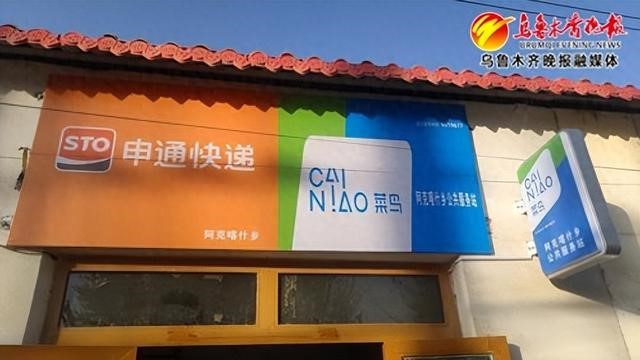Villages in Xinjiang's Kashgar enjoy free shipping services thanks to improved logistics network

Seytnisa Mamat (right) picks up parcels at a courier station. (Photo provided by the postal administration of Kashgar, Xinjiang Uygur autonomous region)
During a break from farm work, Seytnisa Mamat pulled out her phone to track the shipping status of the items she bought online.
"The detergents I bought have arrived. Let me go and get them," the woman said, hurrying towards a courier service station in her village.
On the shelves of the station, parcels were stacked neatly. They were shipped from all parts of China, including Hebei, Shanxi, Zhejiang, Shandong and Guangdong...
Based on a pick-up code sent to her phone, Seytnisa Mamat walked to the corresponding shelf and soon found her parcel.
Seytnisa Mamat lives in Keshlak village, Ishkul township of Yarkant county, Kashgar, northwest China's Xinjiang Uygur autonomous region. Last year, online shopping gained popularity there. Picking up express parcels became a source of delight for villagers.
In the past, bazaars, a type of marketplace consisting of multiple small stalls or shops, were the only place where Seytnisa Mamat and her fellow villagers could buy stuffs. However, the limited variety of products available at bazaars was no longer sufficient to meet everyone's needs.
Later, when courier services were extended to the county town, some villagers would use their relatives' addresses there for online orders, only able to pick up their parcels when visiting the town.
"It was beyond my imagination that we could receive express parcels in such a remote place, with free shipping," Seytnisa Mamat told People's Daily, in a delighted tone.
How remote is the place where Seytnisa Mamat lives?
If she buys an item from Yiwu, east China's Zhejiang province, it has to travel about 4,000 kilometers first to reach Urumqi, the capital of Xinjiang Uygur autonomous region, and then keep going around 1,500 kilometers before arriving at Keshlak village.
How is it possible for Seytnisa Mamat to get this item shipping-free, after all it has to travel 5,500 kilometers?
"The key lies in the lowered transportation costs," said an official with the postal administration of Xinjiang.
Since last year, postal and courier enterprises have joined forces with e-commerce platforms to implement a collective shipping model, which integrates resources across transportation, sorting, and delivery processes, significantly boosting parcel handling efficiency and reducing operational costs, according to the official.
Merchants used to face high costs when they sent parcels to Xinjiang. Today, commodities bought by Xinjiang consumers on e-commerce platforms are distributed first to transit warehouses in different places such as Hangzhou in Zhejiang province and Xi'an in the northwest province of Shaanxi, and then be shipped to their destinations in Xinjiang.
If a village generates sufficient parcel volume, a "village bulk" would be created, which means all the parcels to the village will be shipped directly from a transit warehouse, thus avoiding sorting and repackaging in Urumqi. This greatly saves time and lowers costs.
Besides, the lowered logistics cost is also attributed to China's efforts to shift more freight transport from road to railway. On March 26 this year, the first intermodal express train loaded with containers of e-commerce goods departed from Xi'an, and reached Urumqi 38 hours later.

Express parcels are sorted in Kashgar, Xinjiang Uygur autonomous region. (Photo from zgkashi.com)
According to Yue Wei, director of operations at the Urumqi branch of China United International Rail Containers Co., Ltd., the Xi'an-Urumqi train route is around five hours faster than road transportation, improving delivery speed by 12 percent while reducing freight costs by approximately 57 percent. After arriving in Urumqi, parcels carried by the train are then distributed to villages via a "last-mile" delivery network, Yue said.
At a courier transfer center of delivery company J&T Express in Yarkant county, baskets labeled with village names were neatly arranged on the floor.
"Once the parcels arrive, we directly sort them into the corresponding baskets, pack them up and send them out. Delivery to the villages is possibly even faster than to the county town," said Zhang Haitao, head of the Yarkant office of J&T Express.

Photo shows a courier station in Aqqash township, Kashgar, Xinjiang Uygur autonomous region. (Photo from Urumqi Evening News)
Wang Xiaohu, director of the Kashgar postal administration, told People's Daily that since last year, express delivery services in Kashgar have significantly improved, with free shipping services extended to over 2,000 villages.
"Xinjiang has established e-commerce public service centers, logistics distribution centers, and village-level courier stations. Over 800 e-commerce service sites are integrated with postal and courier functions," said an official with the Xinjiang postal administration.
This will promote e-commerce development in rural Xinjiang and facilitate more agricultural products from the autonomous region to reach markets outside Xinjiang, the official explained.
Photos
Related Stories
- Cultural Bridges: A BFSU scholar's journey at the Xinjiang Museum
- Diversity, unity promote cultural progress in NW China's Xinjiang
- 8th China-Eurasia Expo set for June 26-30 in Xinjiang
- Int'l forum on Xinjiang's history, future held in Kashgar
- Amazing Xinjiang: Nang, the indispensable staple for the people of Xinjiang
- Cultures in Xinjiang propel civilization
- Exploring the enigmatic charms of Urumqi: A journey through time and culture
- Xinjiang sees sports venues boom, adding 30,000 in 5 years
- Xinjiang sees tourism boom during Dragon Boat Festival
- 7-day event featuring hiking and camping launched in Baicheng, China's Xinjiang
Copyright © 2024 People's Daily Online. All Rights Reserved.









